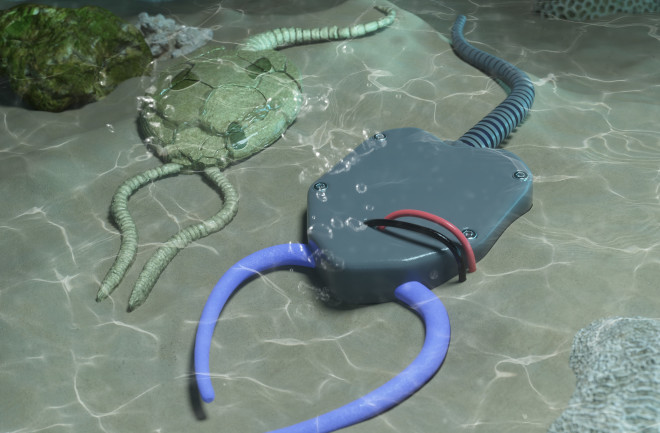Around 500 million years ago, a strange ancestor of the modern sea star, sea urchin, and sand dollar swam above the Paleozoic seafloor. Classified as a pleurocystitid, the animal resembled an armored stingray in its appearance, armed with what looked like a set of swooping antennae.
One of the first of its phylum to move around autonomously, its segmented tail swept from side-to-side to swim forward. Robotics researcher Richard Desatnik and colleagues identified the creature’s method of movement in 2023, after constructing robot replicas of the creature to simulate its swim.
Published in PNAS in November 2023 and set to appear in a presentation at the 68th Biophysical Society Annual Meeting in February 2024, the researchers’ work testifies to the wide variety of applications of ancient-animal-inspired robotics.
Beyond revealing ancient mechanisms of animal movement, for instance, the pleurocystitid bots could contribute to underwater surveying and machine maintenance, the team says. This could mean a potential return of pleurocystitids to the world’s waters, after 500 million years, now in the form of silicone and wire.
Read More: Tiny Robots Are Fishing For Microplastics
What Is Soft Robotics, And What Are Its Applications?
Soft robotics is a subfield of robotics that concentrates on the creation of robots from soft, malleable materials, such as silicone. Bots are therefore much more accurate in mimicking the movement of animals. In fact, in recent years, researchers turned to flexible bots more often as a tool for revealing the biomechanics of animals, including snakes, salamanders, sea turtles, and many more.
But the insights that these robots provide about animal movement aren’t restricted to modern animals. According to Desatnik and colleagues, these robots also mimic the motion of ancient creatures, such as pleurocystitids.
“We’ve learned a lot from modern creatures, but that’s only 1 percent of the animals that have existed during our planet’s history,” said Desatnik in a press release. “We want to see if there is something we can learn from the other 99 percent of creatures that once roamed the earth.”
Read More: The Secrets of Bat Echolocation Could Help Robots Navigate With Sound
What’s Involved in Building Ancient Animal Bots?
Fossil and computer analyses served as the starting point for the team’s bots. The former informed the size and shape of the build and the latter identified which mechanisms of movement were most suitable for a pleurocystitid — a sea-star-, sea-urchin-related creature, armed with a muscular stem, or tail, for movement. Working with silicone and shape memory alloy wire, the team constructed robots with strong, sweeping stems to mimic the motion of the Paleozoic critter.
The robots revealed that the side-to-side swish of the animal’s stem would’ve propelled the pleurocystitid forward. They also revealed that a longer stem would’ve propelled the pleurocystitid forward faster than a shorter stem, a fact that’s seemingly supported in Paleozoic fossils, which featured longer and longer tails over time.
According to the team, taking inspiration from ancient animals could continue to advance the fields of biology, biomechanics, and robotics. Not only that — it is possible that the tactic, which the team calls “paleobionics,” could contribute to the study of the ocean or assist in completing complex tasks underwater, by building on long-lost forms of ancient movement.
“Whether it’s geologic surveying, or fixing all the machinery that we have underwater,” Desatnik added in the press release, the applications of these robots are myriad, meaning that the long-extinct pleurocystitids may be useful to us yet.
Read More: How Could Engineered Gloves Inspired by Octopus Tentacles Help Humans?

